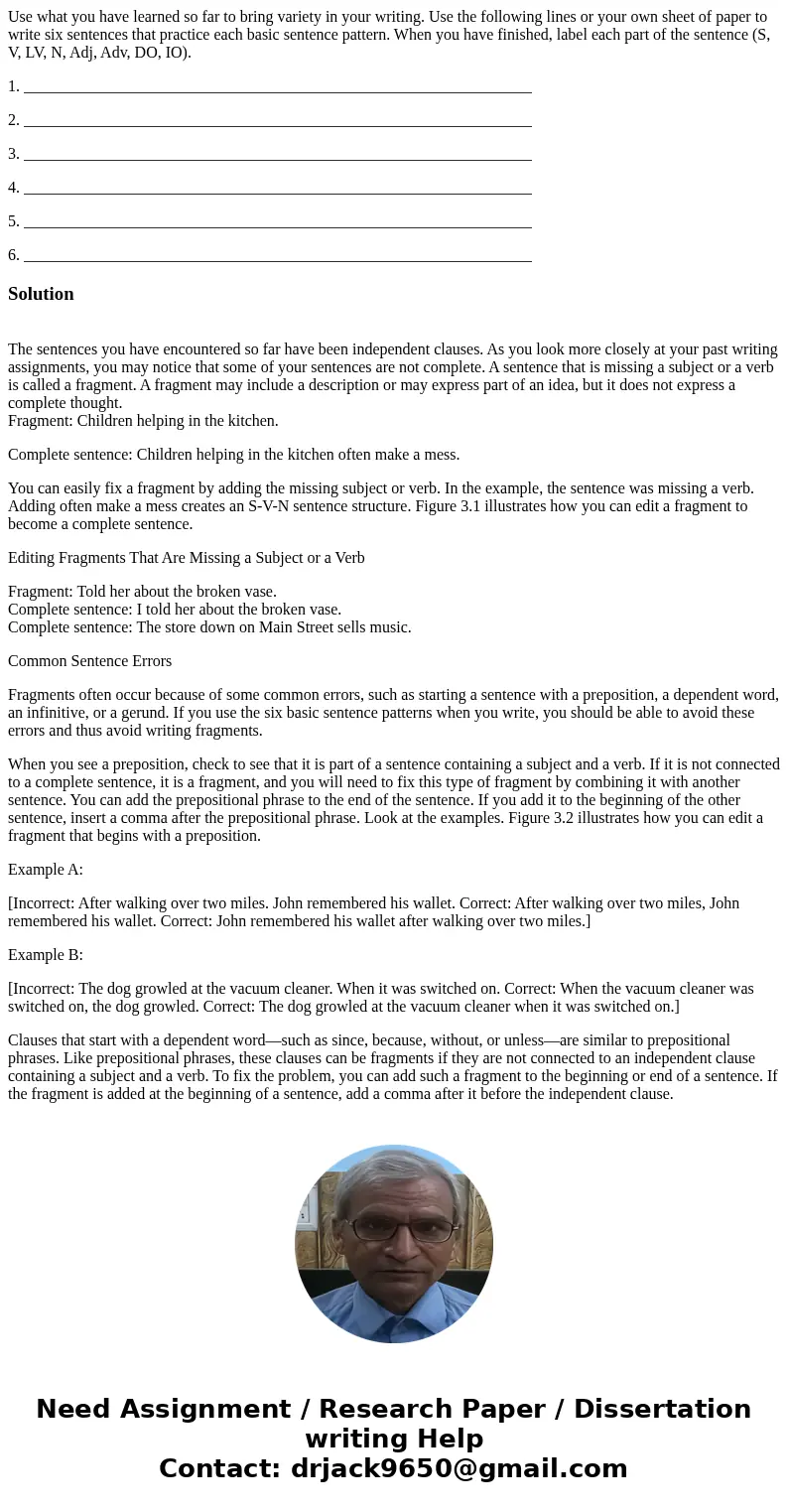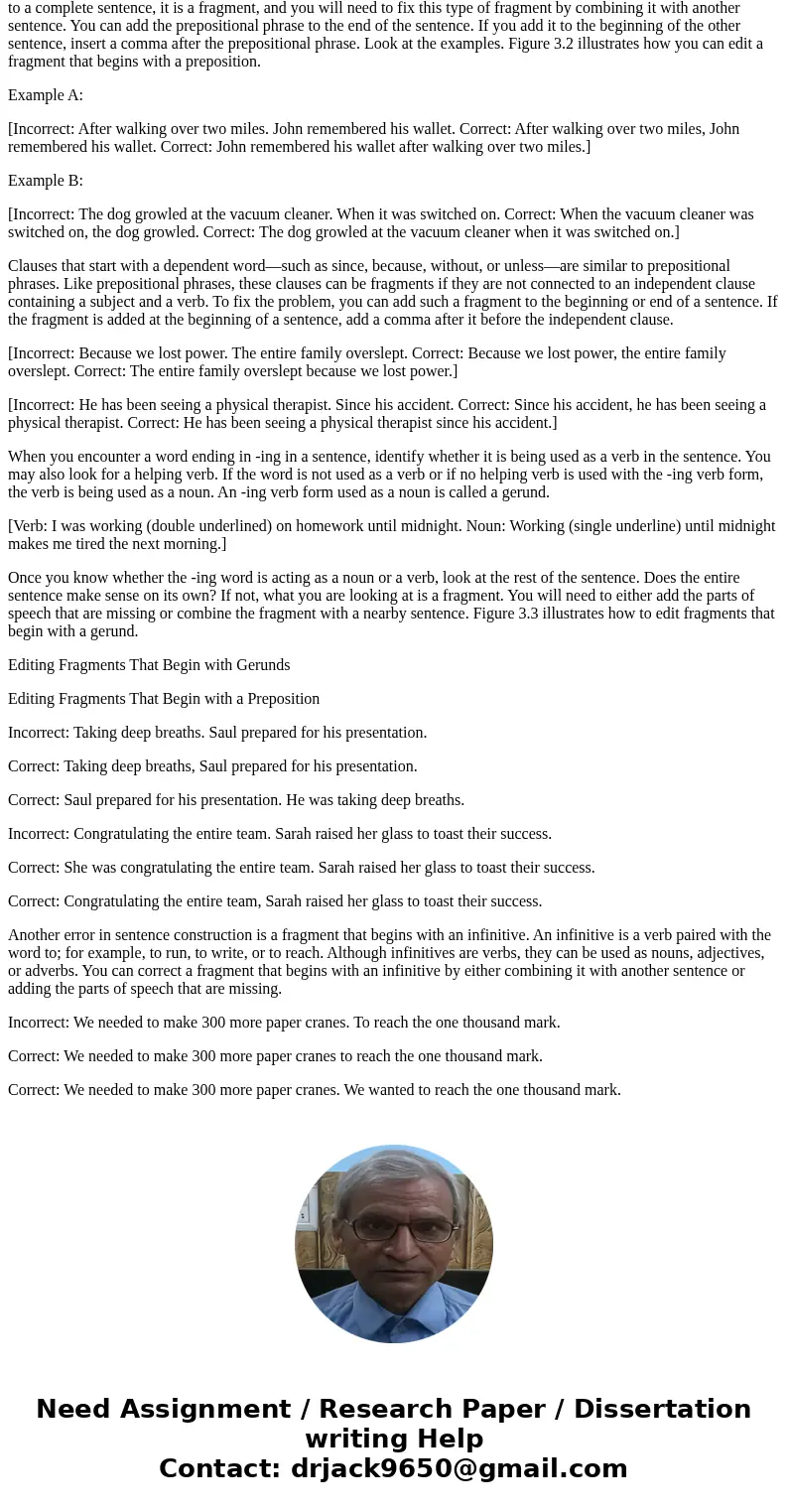Use what you have learned so far to bring variety in your wr
Use what you have learned so far to bring variety in your writing. Use the following lines or your own sheet of paper to write six sentences that practice each basic sentence pattern. When you have finished, label each part of the sentence (S, V, LV, N, Adj, Adv, DO, IO).
1. ________________________________________________________________
2. ________________________________________________________________
3. ________________________________________________________________
4. ________________________________________________________________
5. ________________________________________________________________
6. ________________________________________________________________
Solution
The sentences you have encountered so far have been independent clauses. As you look more closely at your past writing assignments, you may notice that some of your sentences are not complete. A sentence that is missing a subject or a verb is called a fragment. A fragment may include a description or may express part of an idea, but it does not express a complete thought.
Fragment: Children helping in the kitchen.
Complete sentence: Children helping in the kitchen often make a mess.
You can easily fix a fragment by adding the missing subject or verb. In the example, the sentence was missing a verb. Adding often make a mess creates an S-V-N sentence structure. Figure 3.1 illustrates how you can edit a fragment to become a complete sentence.
Editing Fragments That Are Missing a Subject or a Verb
Fragment: Told her about the broken vase.
Complete sentence: I told her about the broken vase.
Complete sentence: The store down on Main Street sells music.
Common Sentence Errors
Fragments often occur because of some common errors, such as starting a sentence with a preposition, a dependent word, an infinitive, or a gerund. If you use the six basic sentence patterns when you write, you should be able to avoid these errors and thus avoid writing fragments.
When you see a preposition, check to see that it is part of a sentence containing a subject and a verb. If it is not connected to a complete sentence, it is a fragment, and you will need to fix this type of fragment by combining it with another sentence. You can add the prepositional phrase to the end of the sentence. If you add it to the beginning of the other sentence, insert a comma after the prepositional phrase. Look at the examples. Figure 3.2 illustrates how you can edit a fragment that begins with a preposition.
Example A:
[Incorrect: After walking over two miles. John remembered his wallet. Correct: After walking over two miles, John remembered his wallet. Correct: John remembered his wallet after walking over two miles.]
Example B:
[Incorrect: The dog growled at the vacuum cleaner. When it was switched on. Correct: When the vacuum cleaner was switched on, the dog growled. Correct: The dog growled at the vacuum cleaner when it was switched on.]
Clauses that start with a dependent word—such as since, because, without, or unless—are similar to prepositional phrases. Like prepositional phrases, these clauses can be fragments if they are not connected to an independent clause containing a subject and a verb. To fix the problem, you can add such a fragment to the beginning or end of a sentence. If the fragment is added at the beginning of a sentence, add a comma after it before the independent clause.
[Incorrect: Because we lost power. The entire family overslept. Correct: Because we lost power, the entire family overslept. Correct: The entire family overslept because we lost power.]
[Incorrect: He has been seeing a physical therapist. Since his accident. Correct: Since his accident, he has been seeing a physical therapist. Correct: He has been seeing a physical therapist since his accident.]
When you encounter a word ending in -ing in a sentence, identify whether it is being used as a verb in the sentence. You may also look for a helping verb. If the word is not used as a verb or if no helping verb is used with the -ing verb form, the verb is being used as a noun. An -ing verb form used as a noun is called a gerund.
[Verb: I was working (double underlined) on homework until midnight. Noun: Working (single underline) until midnight makes me tired the next morning.]
Once you know whether the -ing word is acting as a noun or a verb, look at the rest of the sentence. Does the entire sentence make sense on its own? If not, what you are looking at is a fragment. You will need to either add the parts of speech that are missing or combine the fragment with a nearby sentence. Figure 3.3 illustrates how to edit fragments that begin with a gerund.
Editing Fragments That Begin with Gerunds
Editing Fragments That Begin with a Preposition
Incorrect: Taking deep breaths. Saul prepared for his presentation.
Correct: Taking deep breaths, Saul prepared for his presentation.
Correct: Saul prepared for his presentation. He was taking deep breaths.
Incorrect: Congratulating the entire team. Sarah raised her glass to toast their success.
Correct: She was congratulating the entire team. Sarah raised her glass to toast their success.
Correct: Congratulating the entire team, Sarah raised her glass to toast their success.
Another error in sentence construction is a fragment that begins with an infinitive. An infinitive is a verb paired with the word to; for example, to run, to write, or to reach. Although infinitives are verbs, they can be used as nouns, adjectives, or adverbs. You can correct a fragment that begins with an infinitive by either combining it with another sentence or adding the parts of speech that are missing.
Incorrect: We needed to make 300 more paper cranes. To reach the one thousand mark.
Correct: We needed to make 300 more paper cranes to reach the one thousand mark.
Correct: We needed to make 300 more paper cranes. We wanted to reach the one thousand mark.


 Homework Sourse
Homework Sourse